SAT (Scholastic Assessment Test) is a standard test, used for taking admission to undergraduate programs of universities or colleges of the United States. SAT is developed and published by the College Board, an organization in the United States, administered by the Educational Testing Service. In this article of AKVTutorials, you will get SAT Practice Test 8 Answers | SAT 2024 Prep Online Classes AMBiPi.
SAT Reading Practice Passage
Passage 1 is adapted from Nicholas Carr, “Author Nicholas Carr: The Web Shatters Focus, Rewires Brains.” ©2010 by Condé Nast. Passage 2 is from Steven Pinker, “Mind over Mass Media.” ©2010 by The New York Times Company.
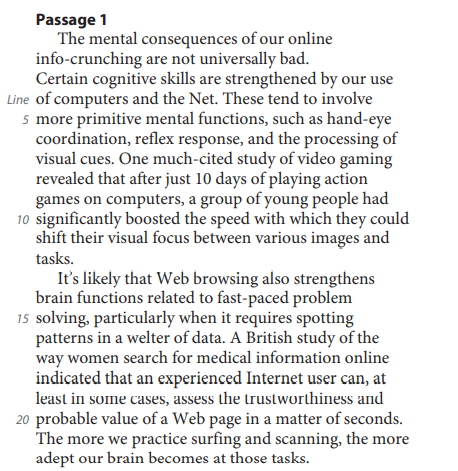
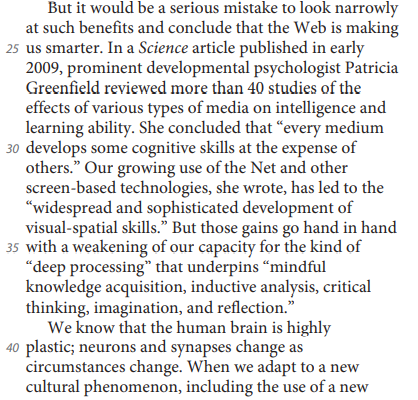
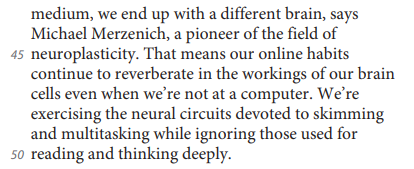
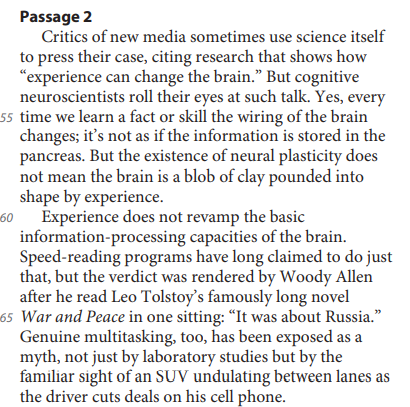
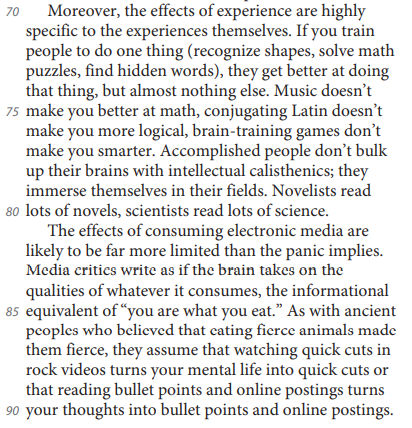
SAT Reading Comprehension Practice Test Questions
SAT Practice Test 8 Question No 1
The author of Passage 1 indicates which of the following about the use of screen-based technologies?
Option A: It should be thoroughly studied.
Option B: It makes the brain increasingly rigid.
Option C: It has some positive effects.
Option D: It should be widely encouraged.
SAT Practice Test 8 Answer No 1
Show/Hide Answer
Option C :
The author of Passage 1 indicates that people can benefit from using screen-based technologies as these technologies strengthen “certain cognitive skills” (line 3) and the “brain functions related to fast-paced problem solving” (lines 14-15).
Choice A is incorrect because the author of Passage 1 cites numerous studies of screen-based technologies. Choice B is incorrect because it is not supported by Passage 1, and choice D is incorrect because while the author mentions some benefits to screen-based technologies, he does not encourage their use.
SAT Practice Test 8 Question No 2
Which choice provides the best evidence for the answer to the previous question?
Option A: Lines 3-4 (“Certain… Net”)
Option B: Lines 23-25 (“But… smarter”)
Option C: Lines 25-29 (“Ina… ability”)
Option D: Lines 29-31 (“She… others”)
SAT Practice Test 8 Answer No 2
Show/Hide Answer
Option A :
In lines 3-4, the author of Passage 1 provides evidence that the use of screen-based technologies has some positive effects: “Certain cognitive skills are strengthened by our use of computers and the Net.”
Choices B, C, and D are incorrect because they do not provide the best evidence that the use of screen-based technologies has some positive effects. Choices B, C, and D introduce and describe the author’s reservations about screen-based technologies.
SAT Practice Test 8 Question No 3
The author of Passage 1 indicates that becoming adept at using the Internet can
Option A: make people complacent about their health.
Option B: undermine the ability to think deeply.
Option C: increase people’s social contacts.
Option D: improve people’s self-confidence.
SAT Practice Test 8 Answer No 3
Show/Hide Answer
Option B :
The author of Passage 1 cites Patricia Greenfield’s study, which found that people’s use of screen-based technologies weakened their ability to acquire knowledge, perform “inductive analysis” and “critical thinking,” and be imaginative and reflective (lines 34-38). The author of Passage 1 concludes that the use of screen-based technologies interferes with people’s ability to think “deeply” (lines 47-50).
Choices A, C, and D are incorrect because the author of Passage 1 does not address how using the Internet affects people’s health, social contacts, or self-confidence.
SAT Practice Test 8 Question No 4
As used in line 40, “plastic” most nearly means
Option A: creative.
Option B: artificial.
Option C: malleable.
Option D: sculptural.
SAT Practice Test 8 Answer No 4
Show/Hide Answer
Option C :
In lines 39-41, the author states, “We know that the human brain is highly plastic; neurons and synapses change as circumstances change.” In this context, the brain is “plastic” because it is malleable, or able to change.
Choices A, B, and D are incorrect because in this context “plastic” does not mean creative, artificial, or sculptural.
SAT Practice Test 8 Question No 5
The author of Passage 2 refers to the novel War and Peace primarily to suggest that Woody Allen
Option A: did not like Tolstoy’s writing style.
Option B: could not comprehend the novel by speed-reading it.
Option C: had become quite skilled at multitasking.
Option D: regretted having read such a long novel.
SAT Practice Test 8 Answer No 5
Show/Hide Answer
Option B :
In lines 60-65, the author of Passage 2 explains how speed-reading does not “revamp,” or alter, how the brain processes information. He supports this statement by explaining how Woody Allen’s reading of War and Peace in one sitting caused him to describe the novel as “about Russia.” Woody Allen was not able to comprehend the “famously long” novel by speed-reading it.
Choices A and D are incorrect because Woody Allen’s description of War and Peace does not suggest he disliked Tolstoy’s writing style or that he regretted reading the book. Choice C is incorrect because the anecdote about Woody Allen is unrelated to multitasking.
SAT Practice Test 8 Question No 6
According to the author of Passage 2, what do novelists and scientists have in common?
Option A: They take risks when they pursue knowledge.
Option B: They are eager to improve their minds.
Option C: They are curious about other subjects.
Option D: They become absorbed in their fields.
SAT Practice Test 8 Answer No 6
Show/Hide Answer
Option D :
The author of Passage 2 states that people like novelists and scientists improve in their profession by “immers[ing] themselves in their fields” (line 79). Both novelists and scientists, in other words, become absorbed in their areas of expertise.
Choices A and C are incorrect because the author of Passage 2 does not suggest that novelists and scientists both take risks when they pursue knowledge or are curious about other subjects. Choice B is incorrect because the author of Passage 2 states that “accomplished people” don’t perform “intellectual calisthenics,” or exercises that improve their minds (lines 77-78).
SAT Practice Test 8 Question No 7
The analogy in the final sentence of Passage 2 has primarily which effect?
Option A: It uses ornate language to illustrate a difficult concept.
Option B: It employs humor to soften a severe opinion of human behavior.
Option C: It alludes to the past to evoke a nostalgic response.
Option D: It criticizes the view of a particular group.
SAT Practice Test 8 Answer No 7
Show/Hide Answer
Option D :
In lines 83-90, the author of Passage 2 criticizes media critics for their alarmist writing: “Media critics write as if the brain takes on the qualities of whatever it consumes, the informational equivalent of ‘you are what you eat.’” The author then compares media critics’ “you are what you eat” mentality to ancient people’s belief that “eating fierce animals made them fierce.” The author uses this analogy to discredit media critics’ belief that the consumption of electronic media alters the brain.
Choices A, B, and C are incorrect because the final sentence of Passage 2 does not use ornate language, employ humor, or evoke nostalgia.
SAT Practice Test 8 Question No 8
The main purpose of each passage is to
Option A: compare brain function in those who play games on the Internet and those who browse on it.
Option B: report on the problem-solving skills of individuals with varying levels of Internet experience.
Option C: take a position on increasing financial support for studies related to technology and intelligence.
Option D: make an argument about the effects of electronic media use on the brain.
SAT Practice Test 8 Answer No 8
Show/Hide Answer
Option D :
The author of Passage 1 argues that online and other screen-based technologies affect people’s abilities to think deeply (lines 47-50). The author of Passage 2 argues that the effects of consuming electronic media are less drastic than media critics suggest (lines 81-82) more receptive to his proposal. In this context, following “form” thus means following a certain tradition or custom.
Choices A and B are incorrect because they discuss points made in the passages but not the main purpose of the passages. Choice C is incorrect because neither passage argues in favor of increasing financial support for certain studies.
SAT Practice Test 8 Question No 9
Which choice best describes the relationship between the two passages?
Option A: Passage 2 relates first-hand experiences that contrast with the clinical approach in Passage 1.
Option B: Passage 2 critiques the conclusions drawn from the research discussed in Passage 1.
Option C: Passage 2 takes a high-level view of a result that Passage 1 examines in depth.
Option D: Passage 2 predicts the negative reactions that the findings discussed in Passage 1 might produce
SAT Practice Test 8 Answer No 9
Show/Hide Answer
Option B :
The author of Passage 1 cites scientific research that suggests online and screen-based technologies harm the brain (lines 25-38). The author of Passage 2 is critical of the research highlighted in Passage 1: “Critics of new media sometimes use science itself to press their case, citing research that shows how ‘experience can change the brain.’ But cognitive neuroscientists roll their eyes at such talk” (lines 51-54).
Choices A, C, and D are incorrect because they do not accurately describe the relationship between the two passages. Passage 1 does not take a clinical approach to the topic. Passage 2 does not take a high-level view of a finding examined in depth in Passage 1, nor does it predict negative reactions to the findings discussed in paragraph 1.
SAT Practice Test 8 Question No 10
On which of the following points would the authors of both passages most likely agree?
Option A: Computer-savvy children tend to demonstrate better hand-eye coordination than do their parents.
Option B: Those who criticize consumers of electronic media tend to overreact in their criticism.
Option C: Improved visual-spatial skills do not generalize to improved skills in other areas.
Option D: Internet users are unlikely to prefer reading onscreen text to reading actual books.
SAT Practice Test 8 Answer No 10
Show/Hide Answer
Option C :
In Passage 1, the author cites psychologist Patricia Greenfield’s finding that “‘every medium develops some cognitive skills at the expense of others” (lines 29-31). In Passage 2, the author states “If you train people to do one thing (recognize shapes, solve math puzzles, find hidden words), they get better at doing that thing, but almost nothing else” (lines 71-74). Both authors would agree that an improvement in one cognitive area, such as visual-spatial skills, would not result in improved skills in other areas.
Choice A is incorrect because hand-eye coordination is not discussed in Passage 2. Choice B is incorrect because Passage 1 does not suggest that critics of electronic media tend to overreact. Choice D is incorrect because neither passage discusses whether Internet users prefer reading printed texts or digital texts.



